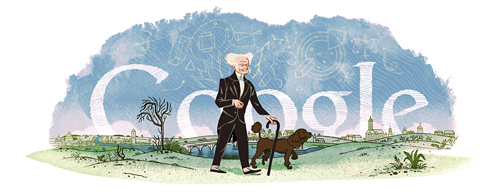
Best known for his thoughts on dissatisfaction and will, German philosopher Arthur Schopenhauer was honored by Google in a doodle that ran in German-speaking countries on his 225th birthday last February 22. The doodle depicted Schopenhauer walking his dog, one of the succession of poodles he had during his lifetime. This philosopher was known to be attached to his poodles, believing them to be essentially similar to humans in terms of will.
Born in Danzig, Germany, Schopenhauer belonged to a wealthy German Patrician family. He was educated in metaphysics and psychology and was exposed to the teachings of Plato and Kant. These influences trailed his own studies towards the exploration of the human will. His most popular work, The World as Will and Representation, was soon published. Although this work stirred a lot of controversy, his lectures did not attract a lot of attendees. As a result, Schopenhauer developed resentment towards the academe. Nevertheless, he continued pursuing his investigation of the human will and motivation. He kept on writing about his theories and philosophies which were akin to Eastern philosophies. Other essays and papers written by this philosopher were published after his death in 1860.
His personal life was not all that pleasant. His father was believed to have committed suicide and his mother left at some point to marry another man. When he reunited with his mother, they continued to be in disagreement with each other. His mother even criticized his work for being incomprehensible. He defended his work nonetheless. It is not surprising that Schopenhauer did not have positive thoughts about marriage. He did not believe in marriage and, although he had some intimate relationships, never thought to get married. He passed on alone on his couch with only his cat keeping him company. He was 72.
Today, Schopenhauer’s works are often part of studies in pessimism. His writings discuss the continuous search of humans for satisfaction. He believes that the human will is driven by need to find satisfaction in various aspects of human life. While he believes that this drive and desire cause human suffering, he also believes that there is a way to ease this pain. This is through aesthetic contemplation or appreciation of the arts. This, however, does not provide permanent relief. Despite this belief, Schopenhauer maintains that music as an art is timeless and universal and can thus be considered as the perfect embodiment of will itself. Complex and profound as Schopenhauer’s philosophies may be, they continue to stir investigations into the human mind and its motivations to this day.
—

What better way to honor an illustrator than by having illustrations of himself published throughout the internet. On his 88th birthday, author-illustrator Edward Gorey was featured on the Google search page. This coincided with the Google Doodle for the 225th birthday of German philosopher Arthur Schopenhauer. While Schopenhauer’s Doodle appeared in Germany and other German speaking countries, Gorey’s Doodle appeared in English speaking countries. Gorey’s Doodle featured several illustrations of his iconic characters.
Popular as a storybook author and illustrator, Gorey’s works are marked with his macabre and ominous style. Aside from his illustrations, Gorey also forayed into set and costume designing. He mounted “Edward Gorey’s Dracula” on Broadway and earned a Tony. This story was published in 1957 and captivated readers with whimsical accounts of a mischievous creature wreaking havoc on the life of a quirky family. In more contemporary times, Gorey’s influences can be observed in the stories and illustrations of Tim Burton. Some of the modern animations are done in his distinct style.
Chicago-born Gorey claims to have inherited his knack for writing and illustrating from his maternal great grandmother. Helen St. John Garvey is known in the 19th century as one of the most popular greeting card writers and artists. He went through school just like every ordinary American, spent a couple of years in the army, and then went to Harvard University for his college education. He graduated in the class of 1950 and later on established, with a group of fellow Harvard graduates, the Poets’ Theater in Cambridge. Just like Schopenhauer, Gorey never married. But while Schopenhauer was known to enjoy sensual relationships, Gorey was never known to have any desire to have such relations.
His first illustrated book covers came in the latter half of the 1950s when he worked for the Doubleday Anchor’s art department. He did illustrations for books of such famous authors as Bram Stoker, H.G. Wells, T.S. Eliot, and then later on Bellairs and Strickland. It was his association with Andreas Brown, owner of the Gotham Book Mark, that propelled Gorey to international fame. The bookstore launched his career and served as the venue for the exhibition of Gorey’s works. Gorey’s home in Cape Cod, Massachusetts now serves as a museum and is called the Elephant House or the Edward Gorey House Museum. After Gorey’s death, Brown discovered a large cache of his unpublished works in the house. The materials were in various stages of completion but are substantial enough to be used as basis for future Gorey feature books and plays.


